1975 – 2010
A hundred yards below the summit and fifty yards north of the main run, a few relics of the old tow remain. A four foot length of railway sleeper stands out of the peat: the top of the Yad Moss ‘2000’ rope tow. Someone should fit a plaque to it;
“Here in 1975 members of the Carlisle Ski Club founded the Yad Moss snow slope opening the way for thousands of skiers and boarders to enjoy their sport in this part of Northern England. Our thanks to those pioneers.”
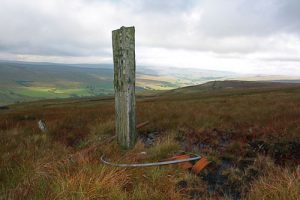
‘Yad’ is an old Pennine word for pit pony. It may be that this area of rough moorland, or ‘Moss’, high above the headwaters of the South Tyne, was used to graze horses from the local lead and coal mines. As you walk up to the ticket office today you still cross the evidence of mining in this area, a series of holes and excavations where a living was scraped from the hillside. There is also, I am told, some evidence that the lead miners themselves used an early form of ski, so perhaps our sport is not quite as new as we sometimes think. Today Yad Moss is one of only four remaining ski areas in northern England equipped with permanent lifts or rope tows. In the early 1980s it was one amongst many.
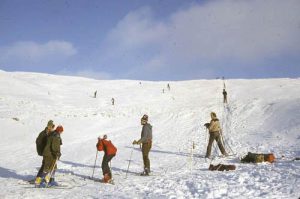 100m portable rope tow in the ‘bowl’
100m portable rope tow in the ‘bowl’
1975 – 1979 The Portable Pioneers
After several years of operating portable ski tows at various locations in the Lake District and on the western side of the Pennines, members of Carlisle Ski Club investigated the potential for skiing at Yad Moss. They set up close to the road and then later on moved up into the ‘bowl’, just above where the ticket office is today. This experience revealed good snow holding at a high altitude yet close to easy road access. The portable tow had the advantage that it could be moved around, in response to changing snow conditions.
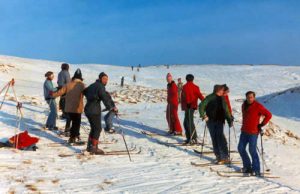 Yad Moss Circa 1979. Always at the cutting edge of ski fashion
Yad Moss Circa 1979. Always at the cutting edge of ski fashion
1979 – 1988 Mini Engines, Seat Belts and Hissing Sid
In 1979 the decision was made to erect a permanent rope tow driven by a fixed diesel engine. Sections of an old hen house were hauled up the hillside to create an engine hut and the first snow fencing was erected. The following winter the Yad Moss ‘2000’ tow came into operation for the first time. It started from a point just below where the ticket office is today and ran 400m up through the ‘bowl’ and across the fellside above. Perhaps uniquely for a rope tow the engine was situated at the halfway point rather than at the summit. This video shows scenes from its construction in 1979 and the first day of skiing using the new tow. It was originally shot on 8mm film.
Such was its success that in 1982 the decision was made to construct a second tow that would extend skiing up to near the summit of Burnhope Seat at 2,400 feet. Together, both tows would serve ski runs of up to half a mile in length and 400 feet in vertical drop.
The second engine hut was built close to where Pylon 4 is today. This tow ran more or less along the current line of the Poma up onto the summit plateau. In typical Yad Moss style it was already very second hand when the Carlisle Ski Club acquired it and it’s design might best be described as ‘unorthodox’. Originally known as ‘The Beast’ it was constructed around a pair of tractor wheels and self propelled by a Mini engine. It had been designed by Frank Keiser, a renowned mechanic from Penrith, and had previously seen service across the valley with the Great Dun Fell Ski Management Committee.  The ‘new’ lift was renamed ‘Sid’s tow’ after ‘Hissing Sid’, a grass snake thought to inhabit the hut, although some believe the hissing sound merely arose from the foundations settling into the peat.
The ‘new’ lift was renamed ‘Sid’s tow’ after ‘Hissing Sid’, a grass snake thought to inhabit the hut, although some believe the hissing sound merely arose from the foundations settling into the peat.
All these rope tows were pretty evil devices. The theory was fine – put your skis on at the bottom of the hill, grab hold of the inch thick polypropylene rope and it will pull you up to the top. In practice with the weight of a dozen skiers, the frozen rope became as hard as a steel rod and very difficult to hold on to. You had to heave it off the ground which caused small children to be lifted off their skis, or else forced down into the peat where the rope crested a ridge. One of the nastier features was the tendency for the rope to twist slowly as it went up the hill, attracting the scarves and anorak toggles of the unwary. Those unable to detach themselves in time were forced to abandon their equipment before they too got dragged through the top pulley.
 Yad Moss 2000 rope tow looking up towards the engine hut. Note the rope tensioning basket
Yad Moss 2000 rope tow looking up towards the engine hut. Note the rope tensioning basket
Almost as hazardously, tension was maintained by a mechanism that involved lifting a 1/2 ton basket of stone 15ft into the air to counteract the stretch of the rope. Occasionally the rope would break and the basket would crash dramatically into the ground.
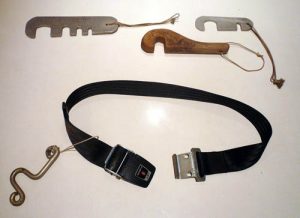 Home made rope tow clips, circa 1986
Home made rope tow clips, circa 1986
Members manufactured their own clips to hold the rope, saving wear and tear on gloves and hands. Eventually the club commissioned a galvanised ‘safety clip’ fitted to a quick release car seatbelt (Kangol made them in Carlisle at the time) and designed so that the whole thing fell off if the skier had a tumble and was being dragged up the hill. The health and safety police would have had a field day – but in all the years there was never a serious accident. After a big snowfall the rope would be buried for much of its length under feet of snow and prospective skiers were obliged to dig it out before the tow could run. Sometimes this could take days.
Around 1982 the ‘2000’ engine hut was extended and for the first time skiers at Yad Moss could seek shelter from the weather. Meanwhile the Mini engine in Sid’s Hut had expired and was replaced by an Austin 1100 motor. This didn’t last long (like all Austin 1100s!) and was finally replaced by a twin cylinder Lister diesel, similar to the successful 2000 tow. Other improvements around this time included the extension downhill of Sid’s tow as far as the fell wall and an ambitious project to install a network of telephones so that the ski tow operators could (in theory) communicate with each other, up and down the hill.
1988 – 2002 Engineers and Architects
In 1987 the decision was made to acquire a second hand Poma tow from a French ski resort, Le Collet d’Allevard near Chambery. The name of the tow, “La Foret”, can still be seen on the casing of the resister cabinet in the control room. To secure the site for future skiing and to enable the club to apply for grants, a lease on the land was acquired for a period of 60 years . The construction project was funded by the club and grant aided by various public bodies, for a total cost of £46k.
The construction of the Poma was an epic of Hollywood proportions. It was undertaken in the summer of 1988 during the most appalling wet weather, on ground that rivalled the Somme and involved heavy, testing and sometimes hazardous work by a hardcore of volunteers. It was an extraordinary achievement. Below is an edited version of a video that was produced at the time.
The ambition, scale, challenge and sheer hard work is well captured. Without the exceptional effort and commitment of those involved the facilities which are enjoyed today would never have been possible.
The new Poma was a step change for the club and successfully replaced the old rope tows but by the turn of the century some of the original buildings were showing their age and Members were starting to tire of the fact that there were still no toilets! Yad Moss was never going to share the reliable skiing conditions enjoyed in the Highlands but throughout the eighties and nineties each winter had brought periods of decent snow cover and these allowed sufficient activity for the club to accumulate capital for investment in new facilities and to satisfy the appetites of regular users. The arrival of the National Lottery Sports fund opened the prospect of the club supplementing it’s own funds and taking another leap forward. A successful application was made to construct a control room and ticket office, clubroom (with toilets) and garage for a pistebasher. The project cost £108k and grant aid of £70k was secured. The balance was made up by cash and in kind contributions from the club. A modern skidoo was acquired and two secondhand piste groomers were purchased from the Cairngorm ski area. Yad Moss was equipped for a great future…….. but the weather Gods had other plans.
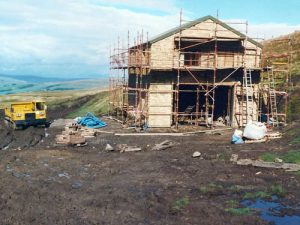 Day lodge and garage 2001
Day lodge and garage 2001
2002 – 2010 Famine and Feast
The new millennium brought with it a change in weather patterns. Poor, short lived snow cover meant that income from day tickets was weak and offered little encouragement to purchase season tickets for the next year. Frugal operation of the tow and a “make do and mend” approach to maintenance restricted spending to the minimum yet significant fixed costs (notably insurance) and occasional unplanned expense (replacing the haul rope cost £8,000 after someone fell off the tow) led the club to the brink of closure. Then the weather changed and, equally importantly, this coincided with the development of the club’s website. More people came to hear about the opportunities at Yad Moss. A new generation of snowboarders and skiers from Newcastle, Manchester, Sheffield, Middlesborough and points between and beyond, discovered the accessible, affordable pleasures of Pennine skiing. Two outstanding seasons, 2008/9 and 2009/10 transformed the club’s finances and established a wide user base at which season and day ticket sales could be pitched. With the proceeds a new (to us) piste groomer was purchased from Italy, plans laid for the refurbishment of the tow and a cash reserve established as a buffer against lean years. Given prudent management of funds and timely use of internet marketing opportunities the club was financially secure for the foreseeable future. In summer 2010, as if to mark this change in fortune, the long disused Yad Moss 2000 engine hut, built by the Members in 1980 and extended in 1982, was demolished, clearing the way for a new future.
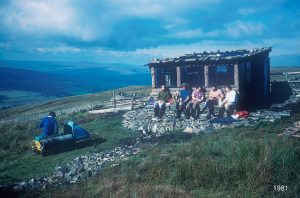
 The end of an era. Yad Moss 2000 hut; 1981 and 2010
The end of an era. Yad Moss 2000 hut; 1981 and 2010
Euan Cartwright, October 2010
My thanks to Gerard Unthank (photos and video), Peter Thompson (photos), David Morton (photos), Brian Hill (video) and many others for their advice and ideas.
© Yad Moss 2013
